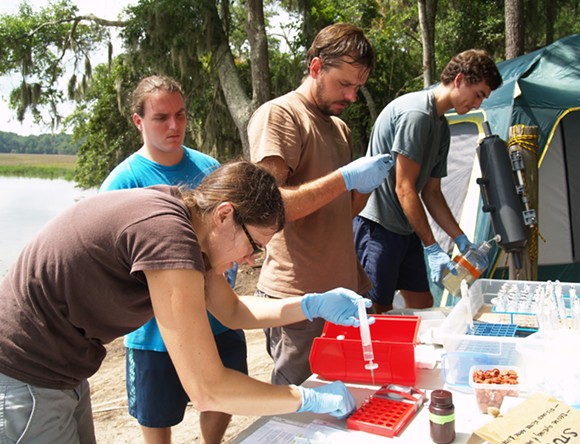The University of Georgia Skidaway Institute of Oceanography completed an intensive, round-the-clock sampling regimen called "26 Hours on the Marsh" this month.
The project was designed to investigate how salt marshes function and interact with their surrounding environment, specifically how bacteria consume and process carbon in the marsh.
The team set up a sampling station and an outdoor laboratory on a bluff overlooking the Groves Creek salt marsh on the UGA Skidaway Institute campus. The scientists collected and processed water samples from the salt marsh every two hours, beginning at 11 a.m. on July 16 and running through 1 p.m. July 17.
“We wanted to be able to compare not only what is happening to the carbon throughout the tidal cycle, but also what the microbes are doing at high and low tides and also during the day and night,” said Zachary Tait, a UGA Skidaway Institute research technician. “So we had to have two high tides and two low tides and a day and night for each. That works out to about 26 hours.”
The research team ran more than 30 different tests on each sample. The samples will provide data to several ongoing research projects.
'26 Hours on the Marsh' research completed
[
{
"name": "Air - MedRect Combo - Inline Content 1",
"component": "14680855",
"insertPoint": "7",
"requiredCountToDisplay": "5",
"parentWrapperClass": "fdn-ads-inline-content-block"
},{
"name": "Air - MedRect Combo - Inline Content 2",
"component": "14680856",
"insertPoint": "15",
"requiredCountToDisplay": "9",
"parentWrapperClass": "fdn-ads-inline-content-block"
},{
"name": "Air - SVP - Leaderboard - Inline Content - 2",
"component": "16852291",
"insertPoint": "10",
"requiredCountToDisplay": "10",
"parentWrapperClass": "fdn-ads-inline-content-block"
},{
"name": "Air - SVP - Leaderboard - Inline Content - 3",
"component": "16852292",
"insertPoint": "20",
"requiredCountToDisplay": "18",
"parentWrapperClass": "fdn-ads-inline-content-block"
},{
"name": "Air - SVP - Leaderboard - Inline Content - 1",
"component": "16852290",
"insertPoint": "25",
"requiredCountToDisplay": "22",
"parentWrapperClass": "fdn-ads-inline-content-block"
}
]


